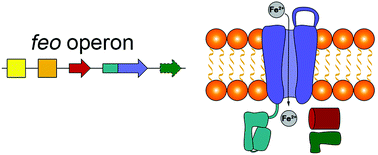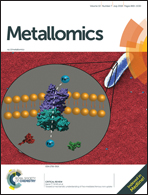Toward a mechanistic understanding of Feo-mediated ferrous iron uptake
Abstract
Virtually all organisms require iron and have evolved to obtain this element in free or chelated forms. Under anaerobic or low pH conditions commonly encountered by numerous pathogens, iron predominantly exists in the ferrous (Fe2+) form. The ferrous iron transport (Feo) system is the only widespread mechanism dedicated solely to bacterial ferrous iron import, and this system has been linked to pathogenic virulence, bacterial colonization, and microbial survival. The canonical feo operon encodes for three proteins that comprise the Feo system: FeoA, a small cytoplasmic β-barrel protein; FeoB, a large, polytopic membrane protein with a soluble G-protein domain capable of hydrolyzing GTP; and FeoC, a small, cytoplasmic protein containing a winged-helix motif. While previous studies have revealed insight into soluble and fragmentary domains of the Feo system, the chief membrane-bound component FeoB remains poorly studied. However, recent advances have demonstrated that large quantities of intact FeoB can be overexpressed, purified, and biophysically characterized, revealing glimpses into FeoB function. Two models of full-length FeoB have been published, providing starting points for hypothesis-driven investigations into the mechanism of FeoB-mediated ferrous iron transport. Finally, in vivo studies have begun to shed light on how this system functions as a unique multicomponent complex. In light of these new data, this review will summarize what is known about the Feo system, including recent advancements in FeoB structure and function.

- This article is part of the themed collection: Recent Review Articles


 Please wait while we load your content...
Please wait while we load your content...